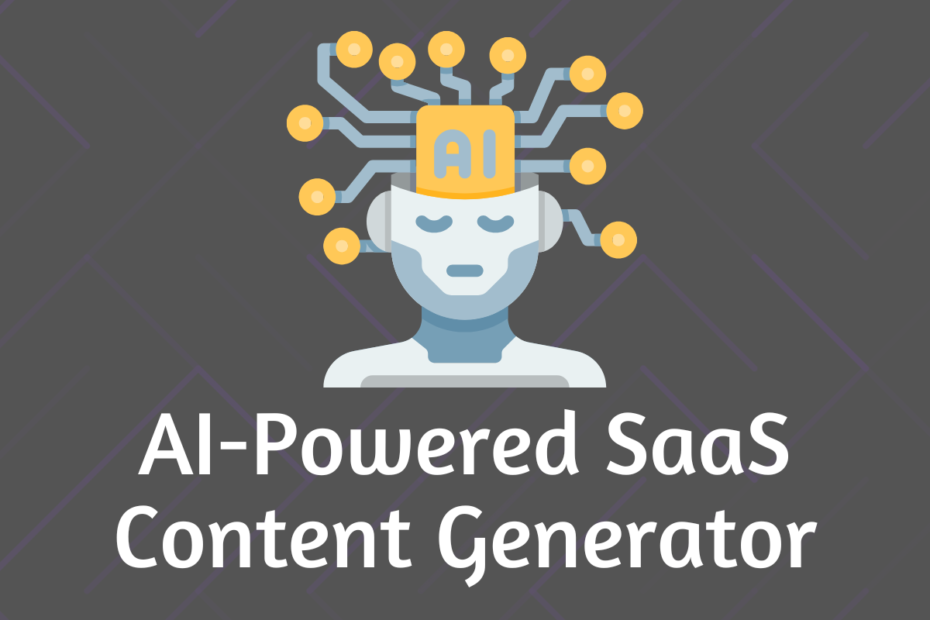In today’s competitive digital landscape, the demand for content continues to surge, and companies seek automated solutions to keep up with content needs. Developing a SaaS (Software as a Service) platform with AI-driven content generation capabilities allows businesses to streamline content production while maintaining quality, relevance, and customization. This guide delves into the essential components, technical requirements, and development strategies required to create an AI-powered SaaS content generator platform.
Introduction to AI Content Generation
AI content generation leverages advanced machine learning and natural language processing (NLP) algorithms to produce high-quality text autonomously. By creating an AI-driven SaaS content generator, companies can offer users the ability to automate their content needs across blogs, social media posts, email marketing, and more.
Key Benefits of an AI-Powered Content Generator SaaS
- Efficiency and Scalability: Generate large volumes of content quickly and consistently.
- Cost Reduction: Reduce dependency on human writers, minimizing costs associated with content creation.
- Customization and Flexibility: Tailor content to specific audience needs, tone, and style requirements.
- Enhanced Content Performance: Use AI analytics to improve SEO, engagement, and conversion rates.
Core Features of a Successful AI Content Generator Platform
1. User-Friendly Interface
A user-friendly dashboard should be intuitive, allowing non-technical users to navigate easily and maximize the platform’s capabilities.
2. Content Customization Options
Allow users to customize content by specifying tone, format, and length. Offer niche-specific settings, such as templates for various industries.
3. Multilingual Support
Enable content generation in multiple languages to expand the platform’s user base internationally.
4. SEO and Keyword Integration
Incorporate SEO tools to optimize generated content for search engines, including keyword integration, readability analysis, and title suggestions.
5. Analytics Dashboard
Provide insights into content performance, including metrics such as engagement rates, SEO rankings, and content readability scores.
6. Content Scheduling and Publishing
Allow users to schedule and automatically publish generated content directly to their blogs or social media.
7. API Integration
Support integration with other software, allowing users to seamlessly incorporate generated content into existing workflows.
8. Robust Security Protocols
Ensure user data security with features like two-factor authentication (2FA), data encryption, and secure access protocols.
Technical Architecture for an AI Content Generator SaaS
Developing an AI-powered SaaS platform involves integrating a variety of technical components and architectural layers.
Frontend Interface
The frontend provides users with tools to input content parameters, review results, and interact with analytics. Use modern frameworks like React, Angular, or Vue.js for a responsive and scalable user interface.
Backend System
The backend handles user requests, content processing, and model interactions. A robust backend system can be built with frameworks like Django, Flask, or Node.js and should support REST or GraphQL APIs for seamless data flow between components.
Machine Learning Model
The core of any AI content generator is its machine learning model. Large language models (LLMs), like GPT or custom-trained BERT models, are ideal for content generation. Fine-tuning these models allows customization for niche-specific requirements, tone adjustments, and targeted keyword integration.
Data Storage and Security
Choose a scalable cloud storage solution such as AWS S3, Google Cloud Storage, or Azure Blob. Ensure security with regular data backups, access control, and encryption protocols.
Content Generation Engine
The generation engine processes user-defined parameters, interacts with the model, and generates content tailored to user needs. Fine-tuning involves balancing creativity with control over style, format, and length.
Steps to Build an AI-Powered Content Generator SaaS Platform
Step 1: Define Target Audience and Niche
Identify the specific audience and industry niche for the platform, which guides model customization, feature prioritization, and marketing strategies.
Step 2: Select and Train AI Models
Use an existing LLM like GPT or develop a proprietary model based on your audience’s specific requirements. Fine-tune the model using industry-specific datasets for accuracy and relevance.
Step 3: Develop Frontend and Backend Components
Focus on a clean, intuitive frontend design and a secure, reliable backend to manage user data and model interactions. Emphasize user experience, speed, and data security.
Step 4: Implement SEO and Content Analytics Tools
Integrate SEO tools and analytics within the platform to allow users to evaluate their content’s performance and optimization potential.
Step 5: Test and Optimize
Conduct extensive testing to ensure the model meets content quality standards. Collect user feedback to refine the model’s tone, length, and SEO relevance capabilities.
Marketing Strategies for an AI-Powered Content Generator Platform
1. Targeted SEO and Content Marketing
Optimize web content, blogs, and landing pages with keywords like “AI content generator,” “automated content creation,” and “AI-powered SaaS platform” to drive organic traffic.
2. Social Media Engagement and Influencer Marketing
Promote your platform through social media channels and collaborate with influencers to raise awareness.
3. Free Trials and Demos
Offer free trials or live demos to allow users to experience the platform’s features, increasing conversion potential.
4. Strategic Partnerships
Partner with digital marketing agencies, SaaS providers, and tech firms to reach a wider audience and establish credibility.
Conclusion
Creating an AI-powered SaaS content generator platform offers immense potential for businesses and content creators alike. By automating content creation, users save time, reduce costs, and improve the quality of their output. With thoughtful implementation and strategic marketing, this platform can meet the growing demand for automated, high-quality content across industries.
